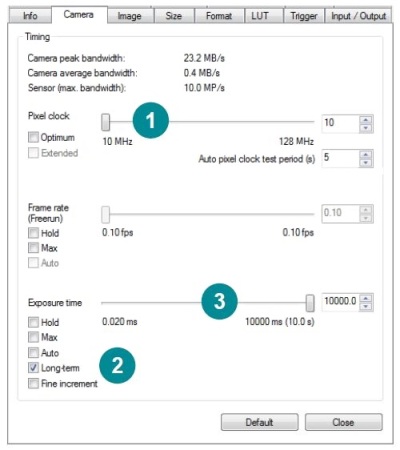|
||||||||||||||||||||||||||||||||||||||||||
|
||||||||||||||||||||||||||||||||||||||||||
Cost-saving capture in low-light
Long exposure with CMOS sensors
Take advantage of lower costs
For the first time, long exposures of up to 10 seconds with a CMOS sensor
is now possible while offering a cost-saving alternative to CCD sensors.
Capturing an image in low-light conditions means working with a high
gain in order to obtain sufficient detail from the image. The trade-off
in using a high gain is that it produces more noise leading to a loss
in image quality. (see fig. 1)
However, long exposure provides the capturing of high-quality images with
low noise even in low light conditions. (see fig. 2)
|
|
||||
Fig. 1 Capture without long exposure |
Fig. 2 Capture with long exposure at 1 Lux
with 10 seconds and double gain |
Why is long exposure useful?
Long exposure is ideal for all applications
where capture is required in low light conditions. Gain does not need
to be increased when exposure time is extended and therefore avoiding
an increase in image noise. This ability is of particular interest, for
example, to microscopy applications which must be conducted in low light
in order not to destroy the light-sensitive sample. Another application
where long exposure is useful is in the field of fluorescence analysis.
Applications in medical technology, quality assurance, mechanical engineering
and astronomy all benefit from this technology.
Using Long exposure: How to
If a long exposure time is required, the camera cannot be used in freerun
mode. Instead, trigger mode with single shots should be adopted and if
using iDS' uEye Cockpit software, clicking ![]() will produce the required result.
will produce the required result.
Also, the timeout must be adjusted to "trigger timeout" for
long exposure to avoid wrong timeout messages. The trigger timeout is
adjusted in the "Trigger" tab of the "Properties"
dialogue box in uEye Cockpit (see fig. 3). If rolling shutter mode is
supported by the camera, this facility should also be chosen.
|
|
 |
| Fig. 3 Increasing
the timeout in uEye Cockpit |
Fig. 4 Activating
the rolling shutter mode in uEye Cockpit |
The pixel clock must also be set to minimum value and a "Long-term" option selected. In this way, the largest possible exposure time increases to the maximum long exposure time. Note this method can also be used for cameras that do not support long exposure. Setting the pixel clock and frame rate to the minimum values will result in achieving the maximum exposure value (Fig 5)
|
|
|||
| IDS
CMOS cameras supporting long exposure |
|||
| USB 2.0 |
USB 3.0 |
GigE |
|
| Fig. 5 Configuring
long exposure in uEye Cockpit |
Use
the links above to read more about each long exposure camera |
||
Adept Turnkey Pty Ltd - Smarter Imaging for Better Lives - are distributors
for iDS imaging products in Australia and New Zealand. To find out more
about iDS, CMOS cameras or any other machine vision product, please call
us at Perth (08) 9242 5411 / Sydney (02) 9905 5551 / Melbourne (03) 9384
1775 or contact us online.
|
If you like this page, please recommend it and share it. |
|||
| More | |||





